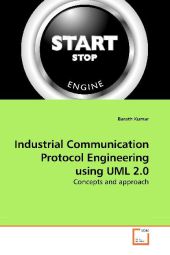 Neuerscheinungen 2010Stand: 2020-01-07 |
Schnellsuche
ISBN/Stichwort/Autor
|
Herderstraße 10
10625 Berlin
Tel.: 030 315 714 16
Fax 030 315 714 14
info@buchspektrum.de |

Barath Kumar
Industrial Communication Protocol Engineering using UML 2.0
Concepts and approach
2010. 76 S. 220 mm
Verlag/Jahr: VDM VERLAG DR. MÜLLER 2010
ISBN: 3-639-25143-1 (3639251431)
Neue ISBN: 978-3-639-25143-2 (9783639251432)
Preis und Lieferzeit: Bitte klicken
The engineering of communication protocols is quite difficult and a complex task, as it demands good experience in the field of protocol and system design, implementation, testing, optimization and maintenance of such protocols. In most cases, these protocols are described using informal techniques like informal textual documentations, graphical description techniques, and structural analysis and design. As proven in practice, these lead to ambiguous definitions and lack of definitions because completeness, and consistency cannot be proved. The advent of Unified Modeling Language version 2.0 (UML 2.0) along with its UML Testing Profile (U2TP)in the recent years, promises to be a major break through in the field of formal description techniques. Thus, this work evaluates the suitability of UML 2.0 combined with its Testing Profile for engineering communication protocols using a case study. For experimental case study, this work uses a simple and the most commonly known INRES (Initiator - Responder) protocol. This book is expected to serve as a good starting point for learning UML 2.0 and protocol engineering.
Barath Kumar is a scientific research assistant at Institute Industrial IT (inIT), Germany. His main research interests include system and protocol engineering using formal languages like timed automata, probabilistic regression automata, UML 2.0 etc. Other interests involve automatic test vector generation from formal models.


